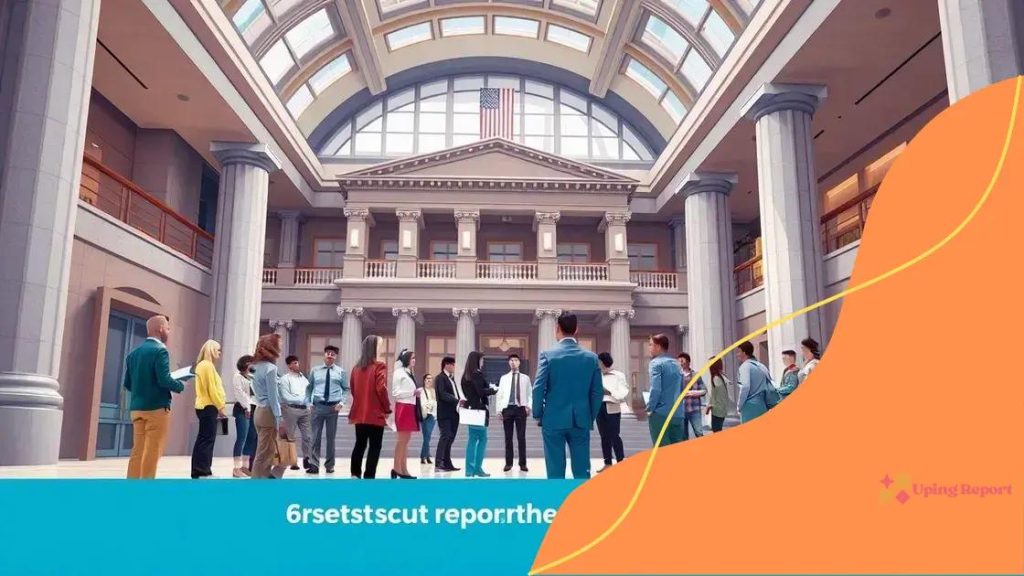Federal agency restructuring efforts: what you need to know

Federal agency restructuring efforts aim to improve efficiency, reduce costs, and enhance service delivery, leveraging technology and accountability to effectively serve citizens better.
Federal agency restructuring efforts are reshaping how government services are delivered. Have you ever wondered how these changes could affect your daily life or business? Let’s dive into the specifics.
Understanding federal agency restructuring
Understanding federal agency restructuring is crucial in today’s evolving political landscape. These efforts aim to create a more efficient government that better serves its citizens. Recognizing the reasons behind these changes helps us appreciate their impact.
The Goals of Restructuring
Federal agencies undergo restructuring to meet specific objectives. These goals often focus on improving efficiency, reducing costs, and enhancing service delivery. When agencies streamline their operations, they can respond more quickly to the needs of the public.
- Enhancing operational efficiency.
- Improving service quality.
- Reducing unnecessary government expenditures.
- Encouraging innovation within agencies.
Furthermore, restructuring can promote a better work environment for employees. With clearer roles and responsibilities, staff can feel more engaged and motivated. A restructured agency can also lead to improved collaboration between departments, fostering a culture of teamwork.
Challenges of Restructuring
However, federal agency restructuring is not without its challenges. Resistance to change can occur among employees who may fear job loss or added stress. Additionally, the processes involved in restructuring can be complex and time-consuming. Effective communication is key to overcoming these issues. Keeping everyone informed can ease anxiety and build trust.
Moreover, it’s essential to involve stakeholders in the restructuring process. Gaining input from employees, management, and the public can lead to better outcomes. When people feel included, they are more likely to support the changes being made.
Ultimately, understanding the reasons for restructuring and the goals behind this initiative allows individuals to engage constructively. As the government evolves, so too does our role as citizens to adapt and contribute positively to these changes.
Key objectives behind restructuring efforts
The key objectives behind restructuring efforts in federal agencies are essential for modernizing government operations. These objectives aim to improve efficiency, reduce costs, and enhance service delivery to citizens. When agencies are restructured properly, the benefits can be significant for both the government and the public.
Improving Efficiency
One of the primary goals of restructuring is to create more efficient systems. By reorganizing internal processes, agencies can minimize wasted resources and time. Streamlined workflows allow employees to focus on their core duties without unnecessary distractions.
- Elimination of redundant tasks.
- Improved collaboration between departments.
- Faster decision-making processes.
- Enhanced resource allocation.
Moreover, efficiency can lead to better outcomes for programs and services provided to the public. When an agency operates smoothly, it can respond more quickly to public needs.
Cost Reduction
Another crucial objective of federal agency restructuring is cutting costs. By identifying areas where money is being wasted, agencies can save taxpayer dollars. This means reallocating funding to necessary services or saving it for future initiatives.
Cost-reduction strategies can include:
- Streamlining services to eliminate waste.
- Reducing staff in non-essential roles.
- Leveraging technology for better productivity.
- Consolidating departments with overlapping functions.
As agencies focus on essential services, they can prioritize spending that directly impacts the public, ensuring that every dollar counts.
Enhanced Service Delivery
Finally, one of the main goals is to enhance the quality of services delivered to citizens. A well-structured agency can provide quicker and more reliable access to services. By focusing on the needs of the public, agencies can create better programs that are responsive to those they serve.
To achieve these goals, agencies must consider feedback from the public and employees. Implementing changes based on real needs can yield significant improvements in satisfaction. Success in these restructuring efforts ultimately leads to a more effective government, which benefits everyone.
Challenges faced during the process

Challenges faced during the restructuring process of federal agencies can significantly impact outcomes. Understanding these challenges helps in navigating the complexities of change. Restructuring is not just about reorganizing; it involves addressing various hurdles that can arise.
Resistance to Change
One of the most common challenges is resistance to change among employees. Many individuals may feel threatened by the prospect of restructuring, worrying about job security and new roles. This fear can lead to a decline in morale and productivity.
- Employees might resist adopting new policies.
- Fear of losing their jobs can create tension.
- Lack of understanding about the benefits of changes.
- Challenges in retaining skilled personnel.
Effective communication is essential to overcome this resistance. Keeping all stakeholders informed and involved can help ease their concerns. A positive approach to addressing fears can foster a more cooperative atmosphere.
Implementation Complexities
Another significant challenge is the complexity of implementing restructuring initiatives. It involves coordinating multiple processes across various departments, which can be cumbersome. Agencies often encounter unexpected issues during the transition, making it crucial to have a flexible plan in place.
Moreover, unforeseen complications can arise, such as:
- Legal and regulatory hurdles.
- Inadequate resources for implementation.
- Conflicts among departments during restructuring.
- Difficulty in measuring success metrics.
Addressing these complexities requires effective leadership and strategic planning. Agencies should prepare for potential roadblocks by anticipating challenges ahead of time.
Maintaining Service Quality
Amid these changes, maintaining service quality is another pressing challenge. As agencies undergo restructuring, they must ensure that services to the public remain uninterrupted. Balancing the transition with ongoing responsibilities can be demanding for government employees.
To mitigate this issue, agencies need to implement solid backup plans and allocate additional resources during the restructuring phase. Training employees adequately for their new roles can also help sustain service quality throughout the changes.
Successful case studies of agency restructuring
Successful case studies of agency restructuring provide valuable insights into how federal agencies can implement effective changes. Learning from these examples helps others understand best practices and potential challenges.
Case Study: The Department of Veterans Affairs
The Department of Veterans Affairs (VA) underwent significant restructuring to enhance healthcare services for veterans. By adopting a patient-centered approach, the VA streamlined operations and reduced wait times for appointments. Key changes included:
- Implementing electronic health records for better tracking.
- Establishing urgent care clinics to accommodate immediate needs.
- Increasing staffing in high-demand areas.
These changes created a more efficient healthcare system that significantly improved patient satisfaction.
Case Study: The Environmental Protection Agency
The Environmental Protection Agency (EPA) restructured to focus more on environmental justice initiatives. They developed new programs aimed at addressing disparities and enhancing community engagement. Notable efforts included:
- Creating dedicated offices for minority and tribal outreach.
- Providing grants for community-led environmental projects.
- Establishing stronger enforcement measures against violators.
These efforts resulted in stronger relationships with underserved communities and better environmental outcomes.
Case Study: The Social Security Administration
The Social Security Administration (SSA) also experienced successful restructuring. They revamped their processing systems to handle claims more efficiently. These improvements included:
- Adopting technology for faster claims processing.
- Providing online options for benefits management.
- Enhancing customer service training for staff.
As a result, the SSA saw a reduction in processing times and higher customer satisfaction rates.
By examining these successful case studies, other federal agencies can learn how to implement effective restructuring efforts. Each scenario showcases the importance of adapting to needs and focusing on service delivery. These examples highlight that with strategic planning and execution, agencies can improve their operations and better serve the public.
Future outlook for federal agencies after restructuring
The future outlook for federal agencies after restructuring is promising. As these agencies adapt and evolve, they can create a more efficient government that better meets the needs of citizens. With strategic changes in place, agencies can enhance service delivery and improve overall functionality.
Embracing Technology
One significant aspect of the future will involve leveraging technology. By adopting advanced systems and tools, agencies can streamline processes and become more efficient. Implementing new technologies can lead to:
- Faster and more accurate data processing.
- Improved communication channels within and between agencies.
- More accessible services for the public.
- Enhanced ability to analyze and respond to public needs.
Agencies that embrace technology can position themselves for success, ultimately providing better services to citizens.
Focus on Accountability
Another critical factor is increased accountability. As federal agencies restructure, there is a growing emphasis on transparency and responsibility. This focus can strengthen trust between the government and the public. Agencies will need to:
- Show measurable results from their restructuring efforts.
- Engage with citizens to gather feedback and input.
- Be open about challenges and successes during the restructuring process.
By fostering a culture of accountability, agencies can enhance their credibility and improve public relations.
Continuous Improvement
The journey doesn’t end with restructuring; federal agencies will need to focus on continuous improvement. Regular assessments and feedback loops can help agencies identify what works and what needs adjustment. Agencies can create effective strategies for long-term success by:
- Establishing clear performance metrics.
- Encouraging innovation and new ideas from employees.
- Maintaining flexibility to adapt to changing conditions.
This commitment to ongoing development will ensure that federal agencies remain relevant and responsive to public demands.
As federal agencies move forward post-restructuring, the focus will be on creating a government that is not only efficient but also genuinely dedicated to serving its citizens effectively.
In conclusion, the restructuring of federal agencies holds the key to enhancing government efficiency and service delivery. By embracing technology, focusing on accountability, and committing to continuous improvement, these agencies can better meet the needs of citizens. The successful case studies highlight the positive outcomes possible through thoughtful restructuring efforts. With a clear vision for the future, federal agencies can evolve into more responsive and effective organizations, ultimately ensuring a better experience for the public they serve.
FAQ – Frequently Asked Questions about Federal Agency Restructuring
Why is restructuring important for federal agencies?
Restructuring is vital to improve efficiency, reduce costs, and enhance service delivery to better serve citizens.
What are the key objectives of agency restructuring?
Key objectives include embracing technology, increasing accountability, and focusing on continuous improvement to adapt to changing needs.
How can successful case studies help other agencies?
Successful case studies provide insights and best practices that other agencies can adopt to implement effective restructuring efforts.
What challenges do agencies face during restructuring?
Challenges include resistance to change, implementation complexities, and maintaining service quality during the transition.
